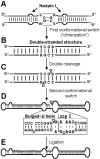Viroid replication: rolling-circles, enzymes and ribozymes
- PMID: 21994552
- PMCID: PMC3185496
- DOI: 10.3390/v1020317
Viroid replication: rolling-circles, enzymes and ribozymes
Abstract
Viroids, due to their small size and lack of protein-coding capacity, must rely essentially on their hosts for replication. Intriguingly, viroids have evolved the ability to replicate in two cellular organella, the nucleus (family Pospiviroidae) and the chloroplast (family Avsunviroidae). Viroid replication proceeds through an RNA-based rolling-circle mechanism with three steps that, with some variations, operate in both polarity strands: i) synthesis of longer-than-unit strands catalyzed by either the nuclear RNA polymerase II or a nuclear-encoded chloroplastic RNA polymerase, in both instances redirected to transcribe RNA templates, ii) cleavage to unit-length, which in the family Avsunviroidae is mediated by hammerhead ribozymes embedded in both polarity strands, while in the family Pospiviroidae the oligomeric RNAs provide the proper conformation but not the catalytic activity, and iii) circularization. The host RNA polymerases, most likely assisted by additional host proteins, start transcription from specific sites, thus implying the existence of viroid promoters. Cleavage and ligation in the family Pospiviroidae is probably catalyzed by an RNase III-like enzyme and an RNA ligase able to circularize the resulting 5' and 3' termini. Whether a chloroplastic RNA ligase mediates circularization in the family Avsunviroidae, or this reaction is autocatalytic, remains an open issue.
Keywords: catalytic RNAs; hammerhead ribozymes; viroids.
Figures




Similar articles
-
Analysis of viroid replication.Methods Mol Biol. 2008;451:167-83. doi: 10.1007/978-1-59745-102-4_12. Methods Mol Biol. 2008. PMID: 18370255
-
Viroids: the minimal non-coding RNAs with autonomous replication.FEBS Lett. 2004 Jun 1;567(1):42-8. doi: 10.1016/j.febslet.2004.03.118. FEBS Lett. 2004. PMID: 15165891 Review.
-
Viroids and viroid-host interactions.Annu Rev Phytopathol. 2005;43:117-39. doi: 10.1146/annurev.phyto.43.040204.140243. Annu Rev Phytopathol. 2005. PMID: 16078879 Review.
-
Involvement of the chloroplastic isoform of tRNA ligase in the replication of viroids belonging to the family Avsunviroidae.J Virol. 2012 Aug;86(15):8269-76. doi: 10.1128/JVI.00629-12. Epub 2012 May 23. J Virol. 2012. PMID: 22623792 Free PMC article.
-
Processing of nuclear viroids in vivo: an interplay between RNA conformations.PLoS Pathog. 2007 Nov;3(11):e182. doi: 10.1371/journal.ppat.0030182. PLoS Pathog. 2007. PMID: 18052530 Free PMC article.
Cited by
-
Natural Cross-Kingdom Spread of Apple Scar Skin Viroid from Apple Trees to Fungi.Cells. 2022 Nov 20;11(22):3686. doi: 10.3390/cells11223686. Cells. 2022. PMID: 36429116 Free PMC article.
-
Next-Generation Sequencing Identification and Characterization of MicroRNAs in Dwarfed Citrus Trees Infected With Citrus Dwarfing Viroid in High-Density Plantings.Front Microbiol. 2021 Apr 30;12:646273. doi: 10.3389/fmicb.2021.646273. eCollection 2021. Front Microbiol. 2021. PMID: 33995303 Free PMC article.
-
Viroids and the Origin of Life.Int J Mol Sci. 2021 Mar 28;22(7):3476. doi: 10.3390/ijms22073476. Int J Mol Sci. 2021. PMID: 33800543 Free PMC article. Review.
-
The Secondary Structure of Potato Spindle Tuber Viroid Determines Its Infectivity in Nicotiana benthamiana.Viruses. 2023 Nov 24;15(12):2307. doi: 10.3390/v15122307. Viruses. 2023. PMID: 38140547 Free PMC article.
-
ASSVd infection inhibits the vegetative growth of apple trees by affecting leaf metabolism.Front Plant Sci. 2023 Feb 24;14:1137630. doi: 10.3389/fpls.2023.1137630. eCollection 2023. Front Plant Sci. 2023. PMID: 36909405 Free PMC article.
References
-
- Gross HJ, Domdey H, Lossow C, Jank P, Raba M, Alberty H, Sänger HL. Nucleotide sequence and secondary structure of potato spindle tuber viroid. Nature. 1978;273:203–208. - PubMed
-
- Diener TO. Discovering viroids—a personal perspective. Nat Rev Microbiol. 2003;1:75–80. - PubMed
-
- Tabler M, Tsagris M. Viroids: petite RNA pathogens with distinguished talents. Trends Plant Sci. 2004;9:339–348. - PubMed
-
- Flores R, Hernández C, Martínez de Alba E, Daròs JA, Di Serio F. Viroids and viroid-host interactions. Annu Rev Phytopathol. 2005;43:117–139. - PubMed
LinkOut - more resources
Full Text Sources

